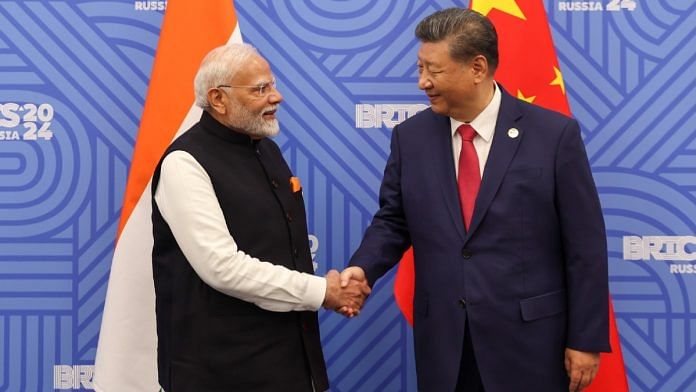New Delhi: Prime Minister Narendra Modi and Chinese President Xi Jinping held bilateral talks for nearly an hour during which the two leaders “affirmed” that “predictable and amicable” bilateral relations between both countries would have “have a positive impact on regional and global peace and prosperity,” on the margins of the BRICS summit Wednesday.
“Welcoming the recent agreement for complete disengagement and resolution of issues that arose in 2020 in the India-China border areas, Prime Minister Modi underscored the importance of properly handling differences and disputes and not allowing them to disturb peace and tranquillity,” said the statement issued by the Ministry of External Affairs (MEA).
It added: “The two leaders agreed that the Special Representatives on the India-China boundary question will meet at an early date to oversee the management of peace and tranquillity in border areas and to explore a fair, reasonable and mutually acceptable solution to the boundary question.”
This bilateral meeting took place two days after India first announced that India and China had arrived at an arrangement for patrolling along the Line of Actual Control (LAC), indicating a thaw after almost four-and-a-half years of a chill in diplomatic ties.
Met President Xi Jinping on the sidelines of the Kazan BRICS Summit.
India-China relations are important for the people of our countries, and for regional and global peace and stability.
Mutual trust, mutual respect and mutual sensitivity will guide bilateral relations. pic.twitter.com/tXfudhAU4b
— Narendra Modi (@narendramodi) October 23, 2024
The two leaders “instructed” their special representatives—National Security Adviser (NSA) Ajit Doval for India and Foreign Minister Wang Yi for China—to meet at an “early date” and to continue the efforts in ensuring peace and tranquillity in the border region, said Vikram Misri, the Indian foreign secretary, at a special briefing held after the bilateral talks.
While Doval and Wang have met at the sidelines of international conclaves, no discussion at the special representative format has been held since December 2019.
The meeting between Modi and Xi was the first in five years, since the 2019 BRICS summit held in Brazil. A month before the BRICS summit, the two leaders held an informal India-China summit at Mamallapuram, Tamil Nadu. The informal summit in October 2019 was held a few months before armed clashes broke out between the two countries at the border, which brought ties to their lowest point in almost six decades.
The two leaders briefly exchanged words at the G20 Leaders’ Summit in Bali in 2022, as well as the Johannesburg BRICS summit in 2023, however, these were not fully structured bilateral talks.
Also Read: Modi pitches for peace in Ukraine, discusses India-Russia economic ties with Putin at bilateral meet
Reviewed state of bilateral ties
Foreign secretary Misri explained that both leaders “reviewed” the state of bilateral ties from a “strategic” and “long-term” perspective, where they agreed that “stable bilateral relations between India and China, the two largest nations on Earth, will have a positive impact on regional and global peace and prosperity”.
“The two leaders stressed that with maturity and wisdom and by showing mutual respect for each other’s sensitivities, interests, concerns and aspirations, the two countries can have a peaceful, stable and beneficial bilateral relationship,” said Misri.
The Indian foreign secretary emphasised the importance of restoration of peace at the border areas, which would give the two countries the “space” for returning diplomatic ties between India and China towards the “path of normalisation”.
While the political situation remained tense between India and China, economic ties continued to grow, with Indian imports of Chinese goods crossing $100 billion in the FY 2023-2024, though exports have largely remained stagnant.
However, India has not allowed the resumption of direct flights between the two countries—a restriction first placed during the COVID-19 pandemic. Moreover, the number of visas given to Chinese citizens have been greatly reduced, while the standoff continued. No discussions were held with this regards.
LAC arrangement
Barring the brief exchanges at Bali and Johannesburg, between November 2022 and February 2024, there were no serious high-level discussions between the two countries. However, in February this year, External Affairs Minister S. Jaishankar held a brief exchange with his Chinese counterpart Wang Yi, which was followed by two official meetings in July between the two ministers.
Meetings between the two foreign ministers were subsequently followed by two meetings of the Working Mechanism for Consultation and Coordination on India-China Border Affairs (WMCC) and a meeting between NSA Ajit Doval and Wang in September this year.
The gathering pace of diplomacy indicated a growing movement towards finding a solution to the current crisis in the border, which was finally achieved in the early hours of Monday. The new arrangement between the two countries saw an agreement on the resumption of patrolling in accordance with the “agreed perceived LAC” including at the Depsang Plains and Demchok, as reported by ThePrint earlier.
The new agreement has also seen the creation of protocols for patrolling that will be done in all areas, as it was before clashes broke out in June 2020. Indian and Chinese armed forces will be allowed to patrol the areas twice in a month, with a fixed contingent of 15 personnel.
Furthermore, both militaries will inform the other before undertaking any patrols across the LAC to reduce the chances for clashes.
Also Read: India unlikely to send representative to Canada for NSA-level meet on Russia-Ukraine war






